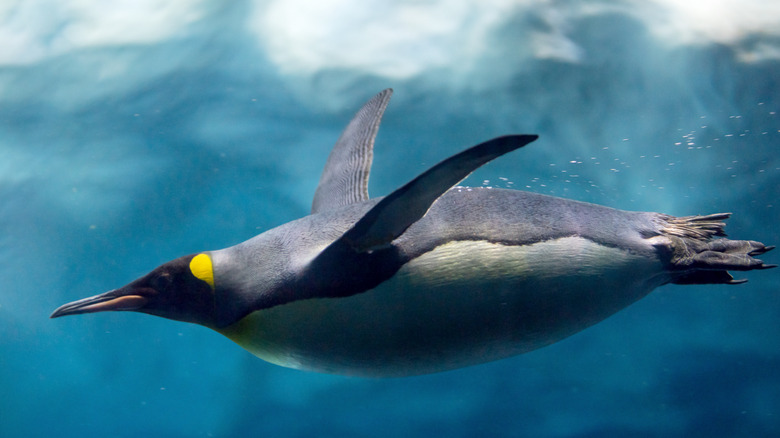The Eye-Opening 2019 Discovery Of The 5-Foot-Tall Penguin
Penguins are some of the world's most remarkable birds. Granted, there's the majestic and iconic bald eagle, the many stunning species of parrot and the cassowary, and Australia's furious feathered fiend (which is dubbed by Guinness World Records as "the world's most dangerous bird"), but penguins have an entirely different sort of appeal.
A popular attraction in zoos and animal parks around the world, there's something unique about these wonderful birds. Penguins are intriguing to watch; so awkward and hoppy on land yet agile, graceful and speedy swimmers in the water.
National Geographic reports that there are a total of 18 penguin species, and that they vary tremendously in size. A penguin can weigh anywhere between two to 88 pounds, and from 16 to 45 inches in size. The latter, National Geographic goes on, is the average height of an emperor penguin, the largest species. Rather, the largest known modern species, because it seems that the ancient world was home to giant penguins that were a good deal taller.
Even bigger than an emperor penguin
Emperor penguins, the name would seem to imply, are the most magnificent, the grandest in stature, of all these fantastic flightless fowl. The WWF reports that they are certainly powerhouses, capable of diving deeper into water than any other bird in the world (an incredible 1,850 feet down in one case). Their height of approximately 115 centimeters puts them at a little under four feet tall, which is certainly intimidating by bird standards.
According to the World Population Review, the average height of women in the United States is 162.56 centimeters (5 feet four inches), and 175.26 centimeters (5 feet 9 inches) for men. Somewhere between emperor penguins and U.S. adults on the height scale, then, came an enormous species of ancient penguin.
In August 2019, Newsweek reported that scientists had discovered some scant bones from the newly-discovered species, which lived up to 66 million years ago in New Zealand.
The giant penguins of prehistory
Per Newsweek, the Natural History Museum Frankfurt and the Senckenberg Research Institute studied the find. Bones from the leg of one penguin, alongside some bones that may have been from its wing, were first found by enthusiast Leigh Love the previous year. The researchers believe that the bird would have been a formidable 176 pounds in weight, and around 5 feet 2 inches tall. The prehistoric world was apparently known for giant penguins.
Gerald Mayr et al published their research in the paper "Leg bones of a new penguin species from the Waipara Greensand add to the diversity of very large-sized Sphenisciformes in the Paleocene of New Zealand" (via Alcheringa: An Australasian Journal of Palaeontology). They gave the bird the scientific name Crossvallia waiparensis, and state that it is comparable in size to a similar species that had been previously discovered, called Crossvallia unienwillia.
Waiparensis, the researchers note, is different than another "unnamed large-sized penguin species from the Waipara Greensand," of which only a distinctive avian leg bone was mentioned as having been found. As the study notes, the evidence that is available seems to make it clear that "penguins attained a very large size early in their evolutionary history."
As for these animals' lives and behaviors, Mayr suggested to Newsweek, " Paleocene penguins have very long, dagger-like beaks. We ... assume [Crossvallia waiparensis] also had a longer beak than extant penguins ... probably due to the fact that these early penguins were predominantly fish-eating."


